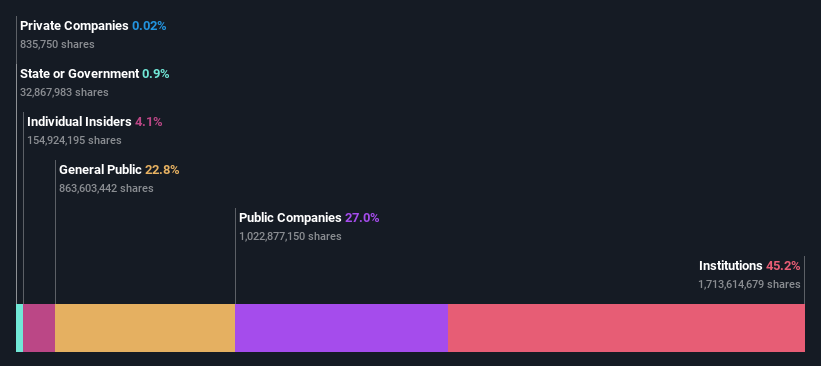Inari Amertron Berhad (KLSE:INARI) institutional owners may be pleased with recent gains after 33% loss over the past year
Key Insights
- Given the large stake in the stock by institutions, Inari Amertron Berhad's stock price might be vulnerable to their trading decisions
- 53% of the business is held by the top 4 shareholders
- Ownership research along with analyst forecasts data help provide a good understanding of opportunities in a stock
If you want to know who really controls Inari Amertron Berhad (KLSE:INARI), then you'll have to look at the makeup of its share registry. And the group that holds the biggest piece of the pie are institutions with 45% ownership. In other words, the group stands to gain the most (or lose the most) from their investment into the company.
Institutional investors would appreciate the 5.1% increase in share price last week, given their one-year losses have totalled a disappointing 33%.
Let's delve deeper into each type of owner of Inari Amertron Berhad, beginning with the chart below.
View our latest analysis for Inari Amertron Berhad

What Does The Institutional Ownership Tell Us About Inari Amertron Berhad?
Many institutions measure their performance against an index that approximates the local market. So they usually pay more attention to companies that are included in major indices.
We can see that Inari Amertron Berhad does have institutional investors; and they hold a good portion of the company's stock. This implies the analysts working for those institutions have looked at the stock and they like it. But just like anyone else, they could be wrong. It is not uncommon to see a big share price drop if two large institutional investors try to sell out of a stock at the same time. So it is worth checking the past earnings trajectory of Inari Amertron Berhad, (below). Of course, keep in mind that there are other factors to consider, too.

Hedge funds don't have many shares in Inari Amertron Berhad. Our data shows that Insas Berhad is the largest shareholder with 27% of shares outstanding. In comparison, the second and third largest shareholders hold about 12% and 10% of the stock. Additionally, the company's CEO Kean Lau directly holds 1.2% of the total shares outstanding.
To make our study more interesting, we found that the top 4 shareholders control more than half of the company which implies that this group has considerable sway over the company's decision-making.
Researching institutional ownership is a good way to gauge and filter a stock's expected performance. The same can be achieved by studying analyst sentiments. Quite a few analysts cover the stock, so you could look into forecast growth quite easily.
Insider Ownership Of Inari Amertron Berhad
The definition of an insider can differ slightly between different countries, but members of the board of directors always count. Management ultimately answers to the board. However, it is not uncommon for managers to be executive board members, especially if they are a founder or the CEO.
I generally consider insider ownership to be a good thing. However, on some occasions it makes it more difficult for other shareholders to hold the board accountable for decisions.
We can see that insiders own shares in Inari Amertron Berhad. This is a big company, so it is good to see this level of alignment. Insiders own RM316m worth of shares (at current prices). If you would like to explore the question of insider alignment, you can click here to see if insiders have been buying or selling.
General Public Ownership
The general public, who are usually individual investors, hold a 23% stake in Inari Amertron Berhad. This size of ownership, while considerable, may not be enough to change company policy if the decision is not in sync with other large shareholders.
Public Company Ownership
Public companies currently own 27% of Inari Amertron Berhad stock. We can't be certain but it is quite possible this is a strategic stake. The businesses may be similar, or work together.
Next Steps:
While it is well worth considering the different groups that own a company, there are other factors that are even more important. For example, we've discovered 1 warning sign for Inari Amertron Berhad that you should be aware of before investing here.
If you are like me, you may want to think about whether this company will grow or shrink. Luckily, you can check this free report showing analyst forecasts for its future.
NB: Figures in this article are calculated using data from the last twelve months, which refer to the 12-month period ending on the last date of the month the financial statement is dated. This may not be consistent with full year annual report figures.
Have feedback on this article? Concerned about the content? Get in touch with us directly. Alternatively, email editorial-team (at) simplywallst.com.
This article by Simply Wall St is general in nature. We provide commentary based on historical data and analyst forecasts only using an unbiased methodology and our articles are not intended to be financial advice. It does not constitute a recommendation to buy or sell any stock, and does not take account of your objectives, or your financial situation. We aim to bring you long-term focused analysis driven by fundamental data. Note that our analysis may not factor in the latest price-sensitive company announcements or qualitative material. Simply Wall St has no position in any stocks mentioned.
 Wall Street Journal
Wall Street Journal